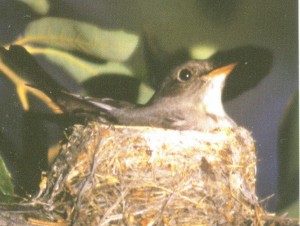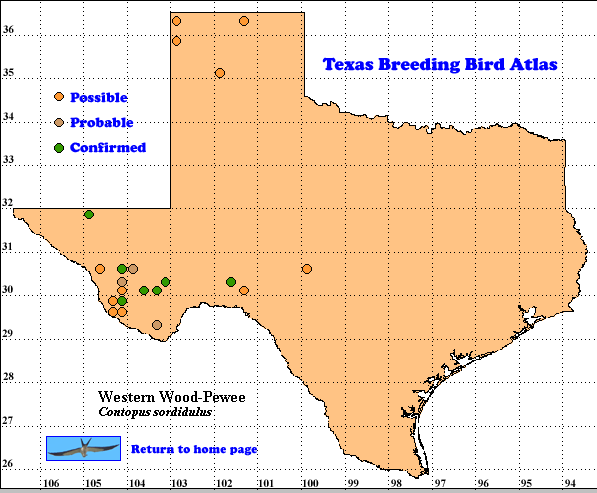Western Wood-Pewee is a small flycatcher, dark grayish brown above and whitish below, very similar in appearance to its close relative the Eastern Wood-Pewee (Contopus virens). Both species forage by sallying out from a perch near the tip of a branch to catch flying insects. Because of their similarity in appearance and behavior, they were once considered conspecific, but their ranges overlap only slightly and hybridization has not been observed at these points. The two species are most easily distinguished by their different vocalizations (McCarty 1996, Bemis and Rising 1999).
DISTRIBUTION. During the 1987-1992 field work of the TBBA project, atlasers found breeding evidence for Western Wood-Pewee in the Guadalupe and Davis mountains and in Big Bend National Park in the Trans-Pecos region of Texas and a few records east of the Pecos River and the west end of the Edwards Plateau. Atlasers also found Eastern Wood-Pewees nesting in the latter area (east of the Pecos River) at the west edge of their breeding range in Texas (McCarty 1996).
The few records from the northern Panhandle may represent late northbound or early southbound migrants.Lockwood and Freeman (2004) note many summer records from this area but no definite nesting evidence.
Outside Texas Western Wood-Pewees breed from southeast Alaska and western Canada (roughly east to the 103rd meridian), south to the Mexican border, then south at the higher elevations of the Sierra Madre Occidental and Sierra Madre Oriental to the highlands of Chiapas (Mexico) and Guatemala (Howell and Webb 1995, Bemis and Rising 1999). After breeding Western Wood-Pewees return to the wintering grounds mostly at mid-elevations of the Andes of South America from Venezuela and Colombia south to Bolivia (Bemis and Rising 1999).
SEASONAL OCCURRENCE. North-bound migrants move through western Texas from about March 3 to June 4 with most passing between mid-April and late May. Breeding occurs from mid-May to early September (egg dates June 5 to August 18). Southward movement takes place between about August 20 and November 9 with most movement from late August to mid-October (Oberholser 1974, Lockwood and Freeman 2004).
BREEDING HABITAT. Western Wood- Pewee breeds in Texas from about 570 to 2550 m (1900 to 8500 ft) elevation in pine-oak woodland in the Trans-Pecos mountains and sycamore-cottonwood-oak habitat near water on the Edwards Plateau (Oberholser 1974).
The nest is saddled on a horizontal branch or fork of a coniferous or deciduous tree, 4.5-12 m (15-40 ft) above ground. It is a shallow cup made of small bits of plant fiber, cottonwood down, fine dry grass and bud scales, neatly woven and decorated on the outside with gray moss. The nest is lined with dry grass. A Western Wood-Pewee’s nest is larger and more deeply hollowed than that of Eastern Wood- Pewee. The outside diameter is 8.5 cm (3.3 in), height 6.5 cm (2.5 in), inside diameter 5 cm (2 in), cup depth 3.5 cm (1.3 in).
The female usually lays 3 (range 2-4) smooth, dull eggs (see Harrison [1979] for photo of markings), similar to those of Vermilion Flycatcher (Pyrocephalus rubinus) but typically less heavily marked. She incubates for about 15 days. The species is an infrequent host to Brown-headed Cowbird (Molothrus ater). The young birds leave the nest 14-18 days after hatching. The species raises one clutch per season. Polygyny has been observed (Oberholser 1974, Harrison 1979, Bemis and Rising 1999).
STATUS. On the 6 North American Breeding Bird Survey (BBS) routes in Trans-Pecos Texas on which Western Wood-Pewees were observed, the average number of individuals reported per 40 km (25 mi) route per year was less than 1. Because the number of observations per year is so small, no meaningful population trend can be derived. Data from all 873 BBS routes across the United States and Canada produce a statistically significant trend of -1.8% population change per year for the period 1966-2004 (Sauer et al. 2005).
Text by Robert C. Tweit (2005)
Literature cited:
Bemis, C. and J. D. Rising. 1999. Western Wood-Pewee (Contopus sordidulus). InThe birds of North America, No. 451 (A. Poole and F. Gill, eds.). The Birds of North America, Inc., Philadelphia, PA.
Harrison, H. H. 1979. A field guide to western birds’ nests. Houghton Mifflin, Boston, MA.
Howell, S. N. G. and S. Webb. 1995. A guide to the birds of Mexico and northern Central America. Oxford University Press, New York.
Lockwood, M. W. and B. Freeman. 2004. The TOS handbook of Texas birds. Texas A&M University Press, College Station.
McCarty, J. P. 1996. Eastern Wood-Pewee (Contopus virens). In The birds of North America, No. 245 (A. Poole and F. Gill, eds.). The Birds of North America, Inc., Philadelphia, PA.
Oberholser, H. C. 1974. The bird life of Texas. University of Texas Press, Austin.
Sauer, J. R., J. E. Hines, and J. Fallon. 2005. The North American Breeding Bird Survey, results and analysis 1966-2004. Version 2005.1. USGS Patuxent Wildlife Research Center, Laurel MD (Web site, http://www.mbr-pwrc.usgs.gov/bbs).

